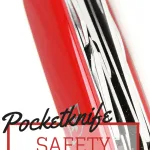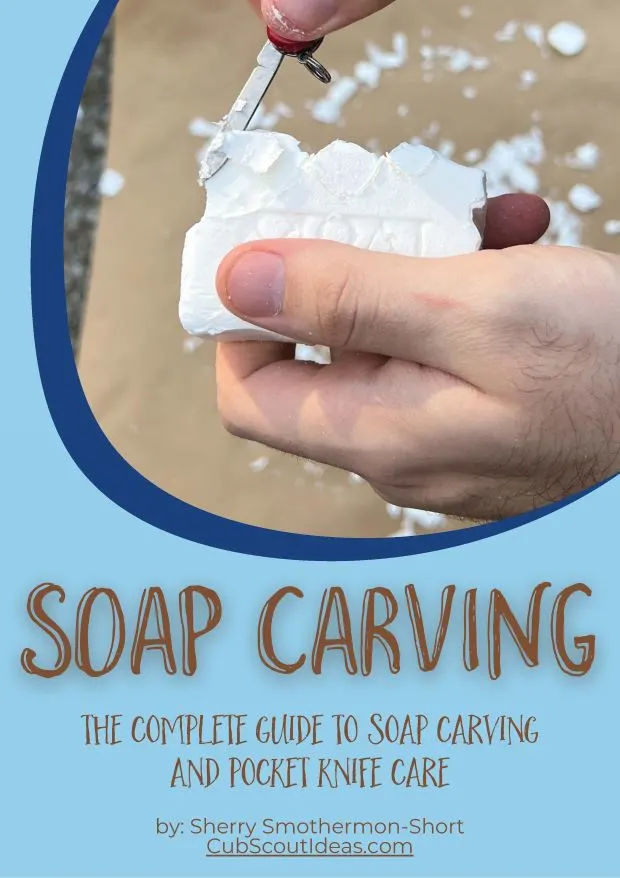Pocketknife safety is important for Cub Scouts to learn. A requirement for the Cub Scout Whittling Chip, it's also just good information for them to know.

Pocketknife safety is one of the life skills our kids learn in Cub Scouts. Learning life lessons
Our Cub Scouts may seem a little young to be learning about knives, but according to BSA’s Age-Appropriate Guidelines, Bears, Webelos and Arrow of Light scouts can use a pocketknife.
In the Cub Scout Adventure program, the Bear and Arrow of Light ranks require knowledge of pocketknife safety.
Bear Adventure: Bear Claws 2: Learn knife safety and earn your Whittling Chip.
Arrow of Light Adventure: Scouting Adventure 6: Demonstrate your knowledge of the pocketknife safety rules and the pocketknife pledge. Earn your Whittling Chip card if you have not already done so.
Below you’ll find the pocketknife safety information that the Scouts need to know to earn their Whittling Chip.
Whittling Chip Pocketknife Safety Rules
- A knife is a tool, not a toy.
- Know how to sharpen a knife. A sharp knife is safer because it is less likely to slip and cut you.
- Keep the blade clean.
- Never carry an open pocketknife.
- When you are not using your knife, close it and put it away.
- Keep your knife dry.
- When you are using the cutting blade, do not try to make big shavings or chips. Easy does it.
- Make a safety circle: Before you pick up your knife to use it, stretch your arm out and turn in a circle. If you can't touch anyone else, it is safe to use your knife.
Although it isn't listed in the Safety Rules published by BSA, one of our readers reminded us about a very important rule. You should always cut away from your body.
Safety Circle aka Blood Circle
The first thing the Scouts need to learn is that they should establish a safety circle, or “blood circle,” in order to safely use a pocketknife. To create the blood circle, grasp a closed pocket knife in your hand.
You should extend your arm with the closed knife straight in front of you. Then rotate your body to either side while continuing to extend the closed knife arm.
No one or thing should be in the imaginary circle that you have created. Also, check your overhead clearance as this is part of your safety circle. If someone enters the circle, the knife should be closed up and laid down.
Knives Are Not Toys
- Close the blade with the palm of your hand.
- Never use a knife on something that will dull or break it.
- Be careful that you do not cut yourself or any person nearby.
- Never use a knife to strip the bark from a tree.
- Do not carve your initials into anything that does not belong to you.
Are you teaching your kiddos how to whittle? Maybe working on earning the Whittling Chip?
Then you need this Soap Carving guide!
In addition to helpful information, you'll find 10 super easy patterns.
These templates will help even the most inexperienced whittler create a cool carving.
Handling a Pocketknife:
- To Open a Pocketknife
- Hold the knife in your left hand, and put your right thumbnail into the nail slot. Pull the blade out while pushing against the hinge with the little finger of your left hand. Continue to hold on to the handle and blade until the blade snaps into the open position.
- To Close a Pocketknife
- Hold the handle in your left hand with your fingers safely on the sides. Push against the back of the blade with the heel of the right hand and swing the handle up to meet the blade. Let the knife snap shut. It’s sometimes easier for the Scouts to use their fingers instead of the heel of the hand.
- To Pass a Pocketknife
- Always close the blade – never pass an open knife. The receiver should get a good grip on the knife and then say “thank you” to indicate that they have a grip on the knife when taking it. The giver should never let go of the knife until the receiver says “thank you” even if the receiver tries to pull it away.
Taking Your Pocketknife With You:
- Knives are usually used as tools, but they can be weapons too. Many places do not allow knives. Always keep your knife at home unless your parent or Den Leader tells you otherwise.
- Places where knives are prohibited even if you have your Whittling Chip card with you:
- School
- Outdoor school events (school football games)
- Airport
- Pack or den meetings, even after you earn the Whittling Chip
- Cub Scout campouts unless there is adult supervision
- You must carry your Whittling Chip card whenever you are using your knife. If you break any of the rules, a corner of the Whittling Chip card will be cut off. When the 4th corner is cut off, the card will be taken from you. If that happens, you must go through training again, in order to receive a new card. The cutting of corners can be done by any adult who feels safety has been violated. For very serious infractions (such as threatening another scout), the card will be taken immediately.
Note: Several people commented about this practice with some great points. I encourage you to read the comments below. The Scouting Magazine blog discusses cutting corners from the Boy Scouts' Totin' Chip. While it isn't the same, I believe the guidance can be applied to the Whittling Chip.
Bears, Arrow of Light and Webelos pocketknife safety knowledge is so important to ensure that our Scouts know how to safely carry and use a pocketknife. I hope this pocketknife safety information has been helpful to you as you plan your Cub Scout Whittling Chip lesson.
Yours in Scouting,
Sherry
P.S. Only you, as a parent, can decide when it's time for your son to own his own pocketknife. If your Cub Scout is mature enough to own a pocket knife, take a look at these available through my Amazon affiliate link.





12 Ways To Make Winter Camping Fun With And Without Snow – Decide Outside – Making Adventure Happen
Tuesday 26th of January 2021
[…] reminder of simple tips to keep you and those around you safe. If you don’t have the manual here are some tips on this blog that go over some safety […]
Bear Claws |
Sunday 12th of January 2020
[…] his knife carving away from him, put his knife down when a buddy came over to ask a question (safety circle), and learned not to be too ambitious about whittling […]
Ed
Thursday 28th of February 2019
The HUGE safety aspect of cutting away from your body when whittling was not mentioned that I could see. I think it is actually one of the most important safety rules and should be added in immediately. Thank you!
Cub Scout Whittling Chip Requirements | Cub Scout Ideas
Wednesday 27th of February 2019
[…] wrote about pocketknife safety, so read that post for some detailed safety information I’ve […]
brian
Sunday 3rd of September 2017
All safety rules are written in blood, which means someone got hurt, then a rule was made to prevent the next guy getting hurt the same way. This should be a guiding principle behind all safety training, and used to explain why safety rules are important.
I have begun today discussing knife safety with my nephew. I came here to be certain I don't miss or gloss over the important bits, and it occurred to me that we as responsible adults and mentors could use some refresher training ourselves.